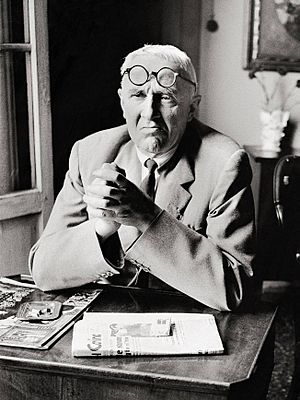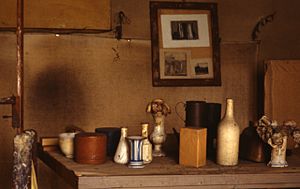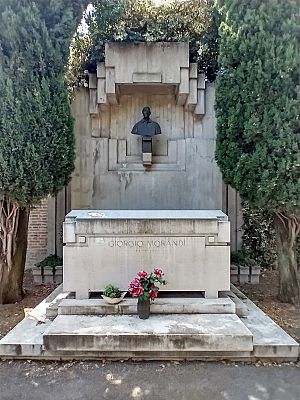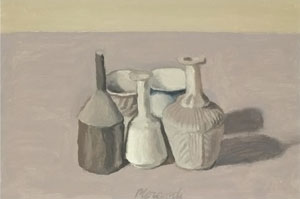Giorgio Morandi facts for kids
Quick facts for kids
Giorgio Morandi
|
|
|---|---|
 |
|
| Born | July 20, 1890 Bologna, Kingdom of Italy
|
| Died | June 18, 1964 (aged 73) Bologna, Italy
|
| Nationality | Italian |
| Education | Accademia di Belle Arti, Bologna |
| Known for | Painting, printmaking |
| Movement | Metaphysical art, futurism, modern realism |
Giorgio Morandi (born July 20, 1890 – died June 18, 1964) was a famous Italian painter. He was also a printmaker, which means he made art using printing techniques. Morandi was best known for his amazing still life paintings. These paintings often showed simple objects like vases, bottles, bowls, and flowers. He also painted beautiful landscapes. His art is special because of how he used colors and shades to make everyday things look unique.
About Giorgio Morandi
Giorgio Morandi was born in Bologna, Italy. He grew up with his brother Giuseppe and his sisters Anna, Dina, and Maria Teresa. After his father passed away in 1909, Giorgio became the head of his family.
From 1907 to 1913, Morandi studied art at the Accademia di Belle Arti di Bologna. This was a famous art school in Bologna. He learned how to etch by studying books about the famous artist Rembrandt. Giorgio was a very good student. However, his teachers sometimes disagreed with his changing art style.
In 1910, he visited Florence. There, he saw paintings by great artists like Giotto and Piero della Francesca. These artworks greatly inspired him. For a short time in 1914, he explored a style called Futurism. In the same year, Morandi started teaching drawing to young students in Bologna. He taught there until 1929. Other artists who influenced Morandi included Paul Cézanne, André Derain, and Pablo Picasso.
In 1915, Morandi joined the army. But he soon became unwell and was sent home. During World War I, his still life paintings became simpler. They showed his admiration for Cézanne and Henri Rousseau.
From 1918 to 1922, Morandi experimented with a style called metaphysical painting. After this, he focused on making small changes in colors and tones. He arranged objects in a soft, hazy way. This became the main style for the rest of his life.
Morandi's art was shown in many exhibitions. He participated in the Venice Biennale, a big art show. In 1948, he won a top prize for his paintings there. From 1930 to 1956, Morandi taught etching at the Accademia di Belle Arti. He visited Paris for the first time in 1956. In 1957, he won another major award at the São Paulo Art Biennial.
Giorgio Morandi was known for being a quiet and polite person. He lived in Bologna with his three sisters. He passed away on June 18, 1964, from lung cancer. He is buried in the Certosa di Bologna with his family. A portrait of him by Giacomo Manzù is on his tomb.
Morandi's Artistic Style
Throughout his life, Morandi mostly painted still lifes and landscapes. He rarely painted anything else, except for a few self-portraits. He was very skilled at using colors and light. He also had a great sense of balance in his paintings. He would paint the same bottles and vases many times. Each painting showed his simple yet powerful style.
Morandi was a very productive artist. He created about 1,350 oil paintings. He also made 133 etchings, which are artworks made by printing. His drawings and watercolors were also very simple and beautiful. He once said that he was most interested in showing "what's in nature, in the visible world."
Morandi is seen as an important artist of his time. His simple, repeated subjects and careful use of color made him a key artist. He helped pave the way for a modern art style called Minimalism. Minimalism uses very simple forms and colors.
Exhibitions of Morandi's Art
Even though Morandi did not focus much on exhibitions during his life, his art has been shown widely. His works have been displayed at the Museo d'Arte Moderna di Bologna (MAMbo). They have also been shown in many other cities around the world.
For example, in 1998, an exhibition called "The Later Morandi" was held. It showed his still life paintings from 1950 to 1964. This show was at the Peggy Guggenheim Museum in Venice. In 2008, a special exhibition of Morandi's art took place at the Metropolitan Museum of Art in New York City.
In 2013, a Morandi exhibition was held in Brussels, Belgium. More recently, in 2015, the David Zwirner Gallery in New York showed his work. From 2015 to 2016, the Center for Italian Modern Art in New York also featured his paintings, etchings, and drawings.
Morandi in Photography
Many famous photographers took pictures of Giorgio Morandi. They photographed him at his home in Bologna and at his other house in Grizzana Morandi. They also took pictures of him at the Venice Biennale. Some of these photographers include Herbert List, Duane Michals, and Lee Miller.
The filmmaker Tacita Dean even filmed inside Morandi's house. An exhibition of pictures from her film, Still Life, was shown in New York in 2016. In 2016, the American photographer Joel Meyerowitz published a book called Morandi's Objects. This book has photos of over 260 objects that Morandi collected and used in his paintings.
Images for kids
See also
 In Spanish: Giorgio Morandi para niños
In Spanish: Giorgio Morandi para niños





